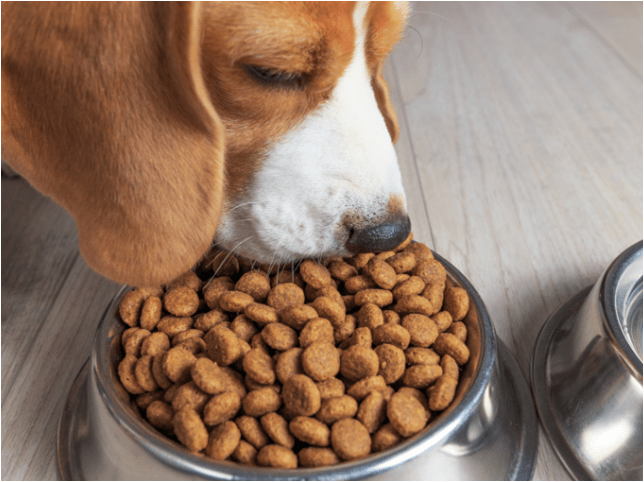Table of Contents
It’s not rocket science to grasp the concept that a properly fed Beagle means a healthy; happy and longer-lived companion, so make sure; that you spend the time to research high-quality food and treats for your happy Beagle.
We are what we eat, and the same is absolutely true for our canine companions.
First, remember that our canine companions are carnivores, which means that they derive their energy; and nutrient requirements and maintain their health by consuming a diet consisting mainly or exclusively of the flesh of animal tissues (in other words, meat).
When choosing an appropriate diet for your Beagle; considering the physiology of the canine’s teeth, jaws; and digestive tract will give you a better understanding of what food they should be eating.
Teeth, Jaws, and Digestive Tract
Teeth: canine teeth are all pointed because they are designed to rip, shred and tear into animal meat and bone.
Jaws: every canine is born equipped with powerful jaws; and neck muscles for the specific purpose of being able to pull down and tear apart their hunted prey.
The jaw of every canine opens widely to hold large pieces of meat and bone; while the actual mechanics of the canine jaw permits only vertical (up and down) movement that is designed for crushing.
Digestive Tract: the canine digestive tract is short; simple and designed to move their natural choice of food (hide, meat and bone) quickly through their systems.
We humans need vegetables and plant matter in our diet and have the flat molars to effectively crush; and chew them. While we often believe our dogs require the same; when choosing an appropriate food source for your Beagle, you need to consider that vegetables and plant matter require more time to break down in the gastrointestinal tract. This in turn, requires a more complex digestive system that the canine body simply does not have.
The canine digestive system is simply unable to break down vegetable matter; which is why whole vegetables look pretty much the same going into your dog; as they do coming out the other end.
Whatever you decide to feed your dog, keep in mind that; just as too much wheat or other grains and fillers in our human diet are having detrimental effects on our human health, the same can be very true for our dogs.
Read the labels so that you can be certain to avoid foods that contain fillers or high amounts of grains; because these are inappropriate for a healthy canine diet.
Control of Your Happy Beagle’s Food
The Beagle will usually have a very healthy appetite; and their superior sense of smell will alert this dog to any potential food source; whether or not it’s part of their usual diet. Conscientious guardians will need to carefully oversee the feed bowl; and exactly what this dog puts in its mouth to ensure that he or she does not become overweight.
As this dog may be prone to eat too quickly; make sure that you purchase a slow feeder type of bowl for them to slow down the pace at which they can consume their food.
It’s important that your Beagle understands that YOU are in control of their food source. Once they understand this, they will also figure; that there will be windows of opportunity for receiving and eating their food; and this routine will help to develop healthy eating habits.
Many people use a scoop or measuring cup to put dry food into their dog’s bowl. This is a mistake; because it’s very important to mix your dog’s food with your hands; so that your scent is all over the food; before you give it to them to eat. This sends a “message” to your dog that you are their pack leader; because it mimics what would happen if you were the alpha dog out hunting for your food in the wild.
For instance, while a pack of wild dogs hunting for food all work hard to capture their prey; the alpha pack leader always gets to eat first while all the other dogs must wait until the leader of the pack eats their fill; before they can rush in to eat what is left over.
Feeding Puppies
You will want to keep in mind that while all puppies require extra protein during the first two years of their life to help them develop into healthy adult dogs; this is especially important with higher energy puppies.
Feeding Adults
Choose foods that list high-quality meat protein as the main ingredient and; depending on your dog’s particular energy level, feed between 2 and 3% of their body weight every day. While some dogs prefer one meal a day, most will appreciate morning food (after a walk) and evening food (after a walk).
Instead, make the time to visit your local pet store, talk with educated representatives; avoid grains, and choose quality sources of meat protein for healthy puppies and dogs; including beef, buffalo, chicken, duck, fish, hare, lamb, ostrich, pork, rabbit, turkey, venison, or any other source of wild meaty protein.
Treats
There are endless choices of dog treats lining the shelves of every feed store, pet store, and grocery store, and it will be an overwhelming task to choose wisely, unless you keep one simple rule in mind, and choose treats that contain only one ingredient or very few ingredients.
Whatever reason you choose to give treats to your Beagle, keep in mind that if we treat our dogs too often throughout the day, they can become overweight, and we may create a picky eater who will no longer want to eat their regular meals.
As well, researchers in Sweden have discovered that dogs were happier when they had to earn their treats as a reward for completing a task, rather than just being given a treat for looking cute, because just like us humans who get that happy “eureka” moment when we finally solve a problem, the same is true for our canine counterparts. The Beagle is the perfect dog for positive training methods that involve treat reinforcement.
Dangerous Treats
Always carefully read labels and take note of where treats are manufactured, because not all countries have the most stringent manufacturing protocols, and honestly there are many treats that you absolutely should NOT be feeding your dog, including: Now that the product is no longer food, it no longer has to comply with food regulations.
While rawhide chews are tough and long lasting, when a dog chews a rawhide treat, they ingest many harsh chemicals. Also, when your dog swallows a piece of rawhide, that piece can swell up to four times its size inside your dog’s stomach, which can cause anything from mild to severe gastric blockages that could become life threatening and require surgery.
Pig’s Ears are very attractive to most dogs that will eagerly devour them. However, they are thin, crispy and very high in fat, which can cause stomach upsets, vomiting and diarrhoea. In addition, pieces can break off and become stuck in a dog’s throat.
Hoof Treats are actual cow, horse and pig hooves that humans believe are healthy, “natural” treat choices for their dogs when the truth is that after processing with harsh chemicals, preservatives and antibiotics, they retain little, if any, of their “natural” qualities.
Also, hooves are very hard and can cause the chipping or breaking of your dog’s teeth as well as perforation or blockages in your dog’s intestines.
Healthy Treats
There are so many healthy treat choices available, which means that there is no excuse for feeding your Beagle unhealthy, nutrient-deficient treats. Examples of healthy treats include:
Hard Treats: come in many varieties of shapes, sizes and flavors and will help to keep your dog’s teeth cleaner.
Soft Treats: are also available in endless varieties and flavors, suitable for all the different needs of our furry friends and are often smaller in size and used for training purposes.
Human Food Treats: be very careful when feeding human foods to dogs as treats, because many of our foods contain unhealthy additives, such as salt, sugar and other ingredients that could be toxic and harmful.
Also, educate yourself about the common human foods that are actually poisonous to our canine friends, such as grapes, raisins, onions and chocolate, to name a few.
Generally, the treats you feed your dog should not make up more than approximately 10% of their daily food intake, so make sure the treats you choose are high quality, with single or few ingredients so that you can help to keep your Beagle both happy and healthy.
The Right Food for Your Happy Beagle
“Dog Food” has significantly changed since 1785, when the English Sportman’s Dictionary described the best diet for a dog’s health in an article entitled “Dog”.
From these meager beginnings, commercially manufactured dog food has become a massively lucrative industry that has only fairly recently evolved beyond feeding our dogs the dregs of human leftovers, because it was cheap and convenient for us.
Even today, the majority of dog food choices often have far more to do with being convenient for humans to store and serve, than it does with being a diet truly designed to be a nutritionally balanced, healthy food choice for our canine companions.
Educating yourself by talking to experts and reading everything you can find on the subject, plus taking into consideration several relevant factors, will help to answer the dog food question for you and your dog.
For instance, where you live may dictate what sorts of foods you have access to, while other factors to consider will include the particular requirements of your dog, such as their age, energy and activity levels.
Our dogs are also suffering from many of the same life-threatening diseases that are commonly found in our human society (heart disease, cancer, diabetes, obesity). These diseases all have a direct correlation with over-feeding and/or eating genetically altered foods that are no longer pure, in favor of a convenient, processed and packaged diet that is quick and easy for us to serve.
The Raw Diet: raw feeding advocates believe that the ideal diet for their dog is one which would be very similar to what a dog living in the wild would have access to while hunting or foraging.
For instance, many guardians of high energy, working breed dogs will agree that their dogs thrive on a raw or BARF (Biologically Appropriate Raw Food) diet and strongly believe that the potential benefits of feeding a raw dog food diet are many, whether your dog is earning a daily working wage or simply being your loyal companion, including:
- Healthy, shiny coats
- Decreased shedding
- Fewer allergy problems
- Healthier skin
- Cleaner teeth
- Fresher breath
- Increased energy levels
- Improved digestion
- Smaller stools
- Strengthened immune system
- Increased mobility in arthritic pets
- Increase or improvement in overall health
A raw diet is a direct evolution of what dogs ate before they became our domesticated pets and we turned toward commercially prepared, easy-to-serve dry dog food that required no special storage or preparation.
While the appearance of dehydrated dog food is very similar to dry kibble, the typical feeding methods include adding warm water before serving, which makes this type of diet both healthy for our dogs and convenient for us to serve.
A dehydrated diet is a convenient way to feed your dog a nutritious diet, because all you have to do is add warm water and wait five minutes while the food re-hydrates so your dog can enjoy a warm meal. Thankfully, there are now many high-quality kibble foods available.
The Right Bowl for the Beagle: there are many different types and categories of dog bowls, including Automatic Watering, Elevated, Ceramic, Stoneware, No Skid, No Tip, Slow Feeder, Stainless, Wooden and Travel Bowls.
Keeping in mind that your Beagle will usually be highly food motivated and may wolf their food, you will definitely want to get this dog a slow feeder type of bowl to help slow them down when they eat.
Foods to Avoid
When owning a dog, it is vital to know what you should and should not be feeding it. There are multiple different foods that can cause sever health problems in dogs – some can even be fatal! It is important to teach your family and visitors on what your Beagle can and can’t eat to avoid someone feeding it something that could damage its health. The following section will outline foods that you should NEVER give to your Beagle:
Avocado
An Avocado’s pit is also very dangerous as it will obstruct your Beagle’s gastrointestinal tract if swallowed.
Grapes and Raisins
Both grapes and raisins have been known to cause seriously health problems in dogs – such as liver damage and kidney failure! It is not currently known what specific chemical in grapes and raisins is toxic to dogs. It takes as little as a handful of grapes to seriously poison your dog!
Chocolate
It contains theobromine, a chemical, which is fatal to dogs. It will cause your Beagle to vomit and have diarrhea. And has the potential to cause seizures and long term damage to your dog’s heart and nervous system!
Coffee and Caffeine
Both coffee and caffeinated products can be fatal if ingested in a high enough quantity. Coffee and caffeine have similar negative effects to chocolate. It causes vomiting, abnormal heart palpitations, seizures and long term damage to the dog’s nervous system. It is important to remember that caffeine can be found in a high number of products such as: energy drinks, tea, chocolate, cocoa beans and medicine.
Macadamia Nuts
It can take as little as five macadamia nuts to have a seriously negative effect on your dog’s health. The symptoms of macadamia nut poisoning include muscle tremors, vomiting, rapid breathing, rapid heartrate, increase body temperature and signs of general weakness.
Xylitol
Xylitol is a sugar based alcohol that can commonly be found in gum, candy, sweet baked goods and other sugar-substitute items. It causes no apparent harm to humans but is extremely toxic to dogs. Even a small dose of xylitol can cause seizures, low blood sugar levels, liver failure and even death in dogs!
Yeast
It will rise and expand in your dog’s stomach in a similar manner to how it rises in bread. A small amount of yeast will cause your dog mild discomfort and to be gassy. However if your dog ingests too much yeast it is likely rupture their stomach lining and intestines! It is important to never feed your dog bread or any other products containing yeast.
Onions, Garlic and Chives
It does not matter what form these produces are in (powdered, raw, cooker, dehydrated or mixed with other foods) they are always detrimental to your dog’s health. Onions, garlic and chives contain disulfides and sulfoxides which can cause anemia and damage to your dog’s red blood cells. Onions, garlic and chives also cause vomiting, breathlessness and general weakness in dogs.
Peaches, Pears and Plums
Peaches contain pits that are potentially a choking hazard to dogs. The pits also contain amygdalin which contains a compound made up of cyanide and sugar that degrades into hydrogen cyanide when metabolized. Hydrogen cyanide is incredibly toxic to dogs and will normally lead to death! Pear seeds contain a small amount of arsenic which is likewise dangerous. It is important to check your backyard for any trees that produce large fruits and seeds. If you find multiple seeds in your dog’s waste it is probably best to cut down and remove the tree.
Cooked Bones
There is a common misconception that all bones are good for dogs. They will also cause your dog a lot of discomfort as they pass the splintered pieces of bone.
Alcohol
Alcohol has the same effect on a dog’s liver and brain as it has on a humans. However the effects of alcohol are greatly amplified on dogs and it therefore takes a lot less alcohol to cause damages – the smaller the dog the greater the effects. A small amount of alcohol can cause vomiting, diarrhea, depression, difficulty breathing, comas and death! Alcohol can obviously be found in beer, liquor and wine but can also been found in some food.
In a Nutshell
While food and treat choices for your favorite furry Beagle can be overwhelming, a basic understanding of canine physiology and making wise decisions concerning all the many different types of food available, will help you to add many healthy and happy years to your dog’s life.
You are the sole protector of your canine companion, and I cannot stress strongly enough the importance of a well thought out choice when deciding what brand and type of food you will feed your loyal Beagle.
Appropriate food and treat choices can not only increase the length of your dog’s life by avoiding unwanted health conditions, such as obesity, high blood pressure or bladder stones, but good food choices will also provide your dog with optimal health so they can feel good and live a happy life!






 Author and long-time animal lover. Sharing knowledge on pet care through experience and the written word.
Author and long-time animal lover. Sharing knowledge on pet care through experience and the written word. 